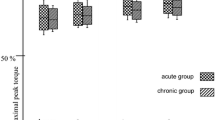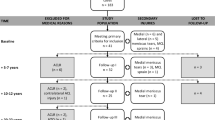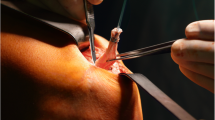Abstract
Between 1982 and 1984, 49 patients with fresh isolated proximal ruptures of the anterior cruciate ligament (ACL) were operated on in the Trauma Hospital, Salzburg. The operation was performed within 1 week of trauma. The operational technique used was proximal reinsertion of the ruptured ACL alone. Postoperatively the knee was immobilized for 6 weeks in an above-theknee plaster cast. We were able to re-examine 42 of the 49 patients 5–7 years after injury. In addition to a clinical examination, testing with a KT-1000 arthrometer was performed. The objective and subjective results we found were evaluated using the Lsyholm score and OAK knee evaluation form. We found 12 (29%) absolutely stable knee joints. We accepted a KT-1000 result of up to 3 mm as satisfactory, and 81% of our patients were in this category. The same percentage (81%) scored between 85 and 100 points on the Lysholm scale. Only 52% scored over 90 points on the OAK form. Subjectively only 6 patients (14%) were dissatisfied with their result.
Zusammenfassung
Zwischen 1982 and 1984 wurden im Unfallkrankenhaus Salzburg 49 Patienten mit frischen isolierten proximalen Rupturen des vorderen Kreuzbandes operiert. Die Operation erfolgte bei allen Patienten innerhalb der 1. Woche nach dem Trauma. Die von uns durchgeführte Operationstechnik war die alleinige proximale Reinsertion des gerissenen vorderen Kreuzbandes über 2 Bohrkanäle transossär bzw. über einen transossären Bohrkanal und “over the top”. Die postoperative Ruhigstellung erfolgte im Oberschenkelgehgipsverband für insgesamt 6 Wochen. 42 unserer 49 operierten Patienten konnten wir zwischen 5 und 7 Jahre postoperativ nachuntersuchen. Dabei wurde neben der klinischen Stabilitätsprüfung auch eine Stabilitätsprüfung mit dem KT 1000 durchgeführt. Die objektiven und subjektiven Ergebnisse wurden nach dem Lysholm Scale und nach dem OAK-Bogen ausgewertet. Dabei fanden wir in 29% absolut stabile Kniegelenke. Gibt man sich mit einem KT 1000 Meßwert bis zu 3 mm zufrieden, so fielen 81% unserer Patienten in diese Kategorie. Der Lysholm Score lag ebenfalls bei 81% und über 85 Punkten. Im OAK-Bogen wiesen lediglich 52% über 90 Punkte auf. Subjektiv waren nur 14% unserer Patienten mit dem Ergebnis unzufrieden.
Similar content being viewed by others
References
Anderson C, Odensten M, Gillquist J (1989) Early arthroscopic evaluation of acute repair of the anterior cruciate ligament. Arthroscopy 5: 331–335
Balkfords B (1982) The course of knee ligament injuries. Acta Orthop Scand [Suppl] 198
Cabaud HE, Feagin JA, Rodkey WG (1980) Acute anterior cruciate ligament injury and augmented repair. Experimental studies. Am J Sports Med 8: 395–401
Feagin JA, Curl WW (1976) Isolated tear of the anterior cruciate ligament. Five-year-follow up study. Am J Sports Med 4: 95–100
Lysholm J, Gillquist J (1982) Evaluation of knee ligament surgery results with special emphasis of use of a scoring scale. Am J Sports Med 10: 105–114
Müller W (1982) Das Knie. Springer, Berlin Heidelberg New York
Müller W, Biedert R, Hefti F, Jakob RP, Munzinger U, Stäubli HU (1988) OAK knee evaluation. A new way to assess knee ligament injuries. Clin Orthop Relat Res 232: 37–50
Noyes FR, Mooar PA, Matthews DS, Butler DL (1983) The symptomatic anterior cruciate-deficient knee. Part. I. The longterm functional disability in athletically active individuals. J Bone Joint Surg [Am] 65: 154–162
Noyes F, Matthews DS, Mooar PA, Grood ES (1983) The symptomatic anterior cruciate-deficient knee. Part II. The results of rehabilitation, activity modification, and counselling on functional disability. J Bone Joint Sug [Am] 65: 163–174
Noyes FR, Butler DL, Paulos LE, Grood ES (1983) Intra-articular cruciate reconstruction. Part I. Perspectives on graft strength, vascularization and immediate motion after replacement. Clin Orthop 173: 71–77
Noyes FR, Butler DL, Paulos LE, Grood ES (1983) Intra-articular cruciate reconstructions. Part II. Replacement with vascularized patella tendon. Clin Orthop 172: 78–84
Odensten M, Hamberg P, Nordin M, Lysholm Y, Gillquist J (1985) Surgical or conservative treatment of the acutely torn anterior cruciate ligament. A randomized study with shortterm follow-up observations. Clin Orthop 198: 87–93
Palmer I (1938) On the injuries to the ligaments of the knee joint. A clinical study. Acta Chir Scand 81 [Suppl 53]: 9–282
Tegner Y, Lysholm J (1985) Rating systems in the evaluation of knee ligament injuries. Clin Orthop 198: 43–49
Trillat A, Dejour H, Bousquet G (1978) Chirurgie du genou, 3 ièmes Journèes Lyon, September 1977, Simep-Editions, Villeurbanne, France, Simep
Author information
Authors and Affiliations
Additional information
Dedicated to Prof. Dr. H. Möseneder on his 60th birthday
Rights and permissions
About this article
Cite this article
Genelin, F., Trost, A., Primavesi, C. et al. Late results following proximal reinsertion of isolated ruptured ACL ligaments. Knee Surg, Sports traumatol, Arthroscopy 1, 17–19 (1993). https://doi.org/10.1007/BF01552153
Issue Date:
DOI: https://doi.org/10.1007/BF01552153




